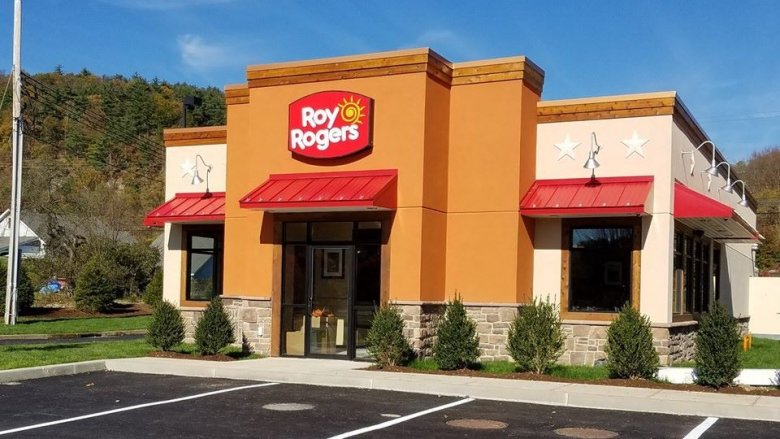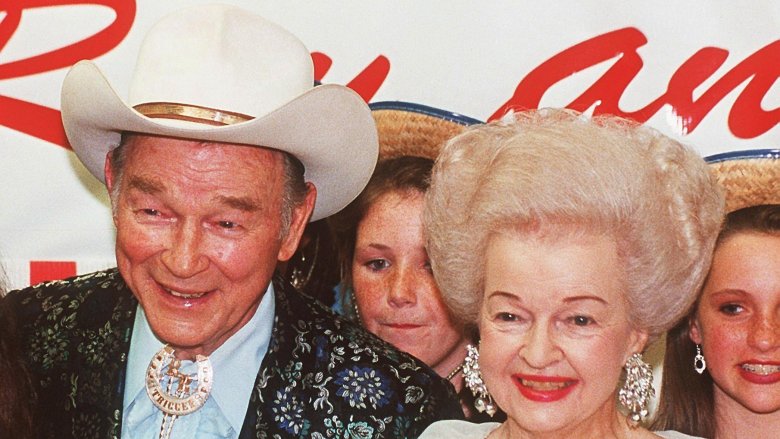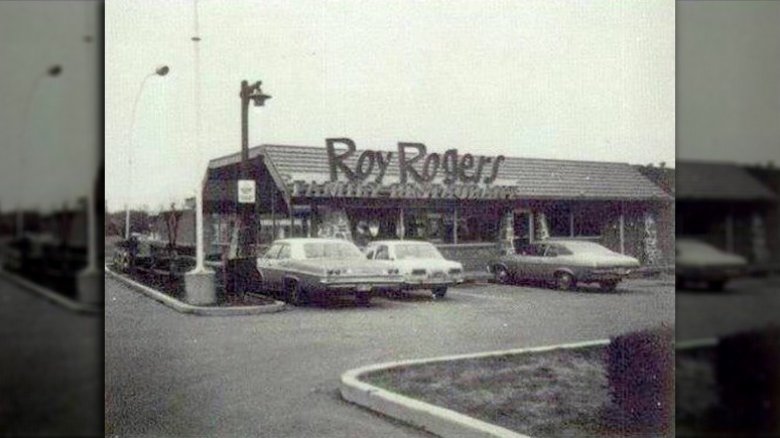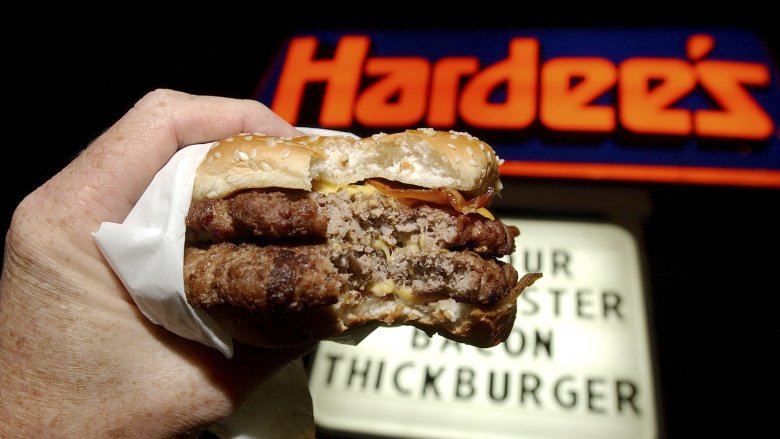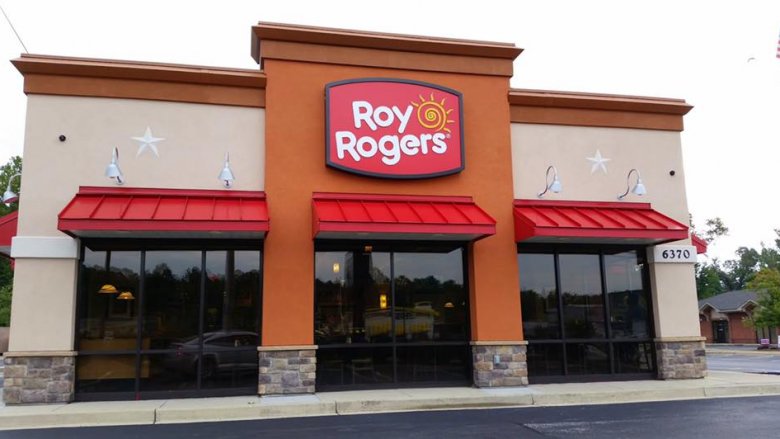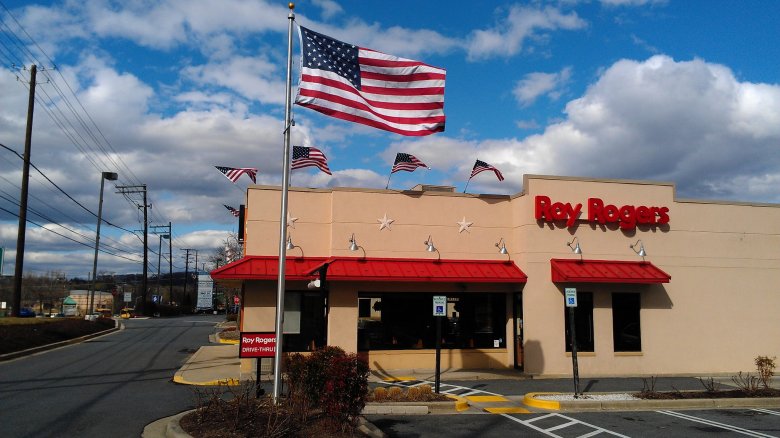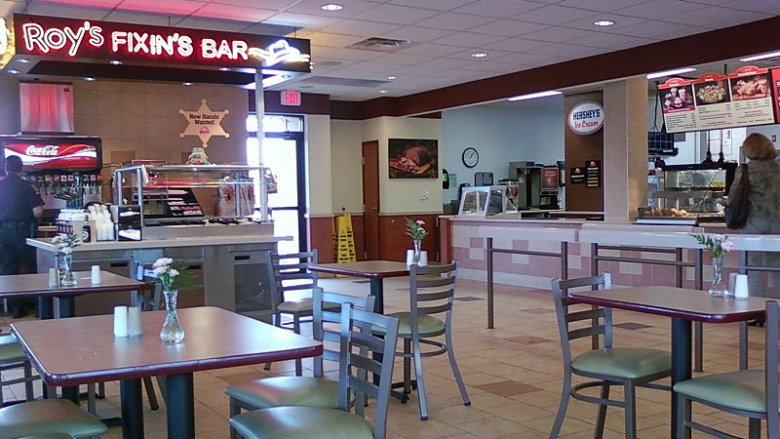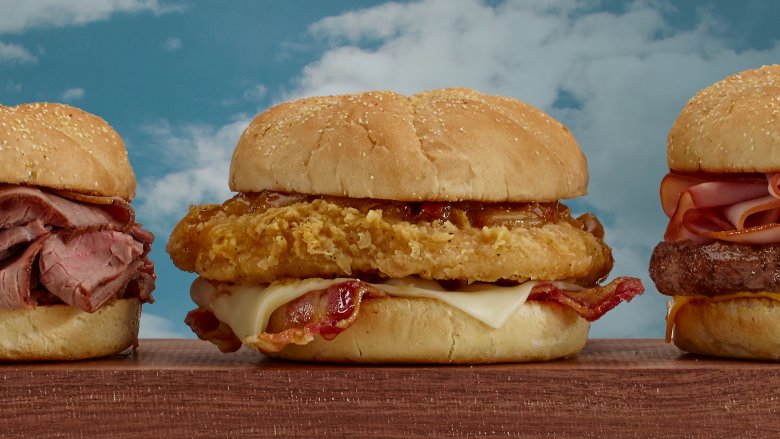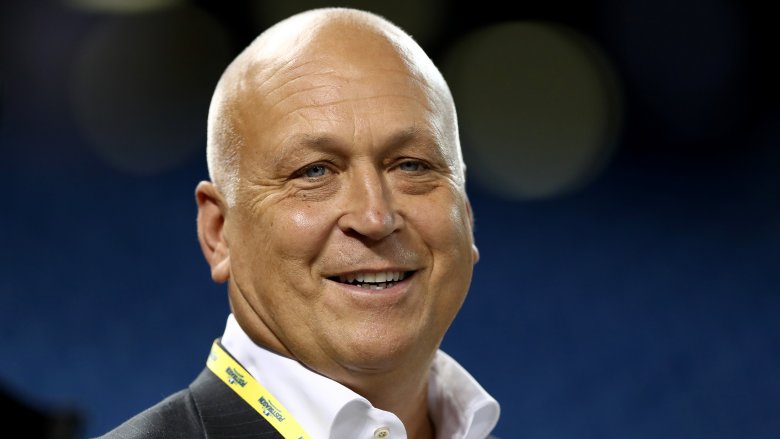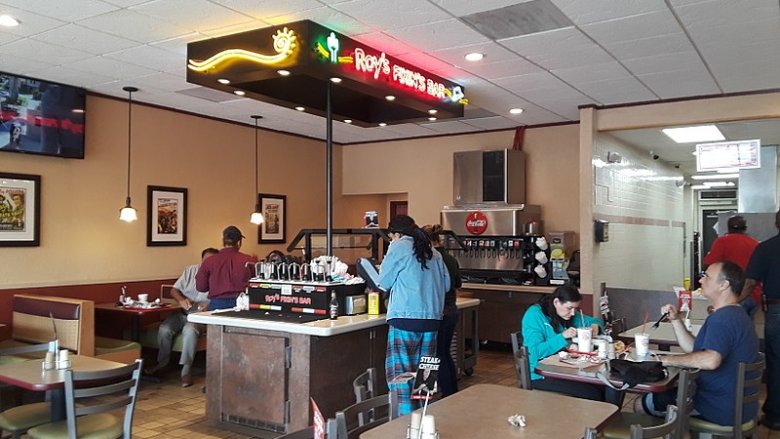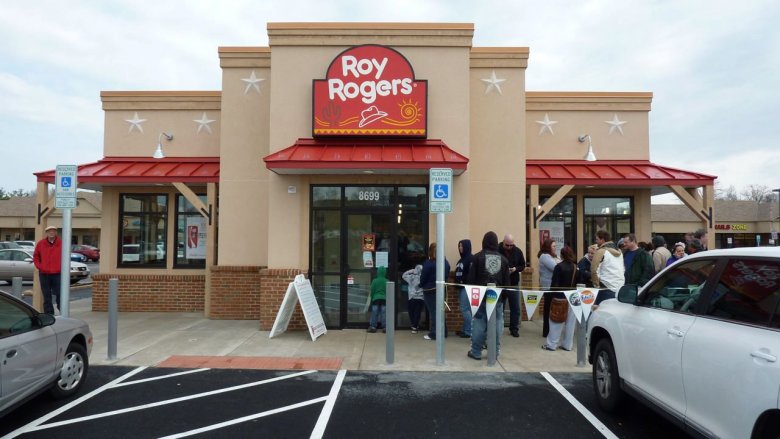The Untold Truth Of Roy Rogers
The first Roy Rogers opened in Falls Church, Virginia in 1968, and by 1990, it was an East Coast staple with 648 restaurants in operation at one point. It has managed to maintain somewhat of a cult following — despite various changes of ownership and a sharp decline in the number of restaurants over the years — but there were so few units left by the late 1990s that many questioned whether the chain would survive. Thanks to a family that's had ties to the Roy Rogers brand since its infancy, though, it's been making a slow but steady comeback.
Its resurgence comes with an appeal to younger clientele, with updated technology and a promise of fresh ingredients, but also a reminder of why it was so good in the first place. For fried chicken, roast beef sandwich, or hamburger lovers, it's truly a match made in fast food heaven. It's important to know the history of the Roy Rogers establishment to really appreciate the delicious grub it hustles up today, so let's dive in.
Its namesake was no stranger to branding himself with food
Actor/singer/cowboy Roy Rogers (who was born Leonard Franklin Slye) certainly had no qualms about putting his name on the line in order to sell some grub. In addition to the restaurant that bore his actual name for their title, he also endorsed cereal, salad dressing, and Nestle's Quik in commercials over the course of his career. His famous wife Dale Evans wasn't afraid to hock product on camera either. It's a surprise they even had time for commercials — the two made 88 movies together in the 1940s.
Based on his experience selling food in commercials, it's no surprise Rogers killed it in the commercials for Roy Rogers restaurants, where he comes across like a guy constantly checking up on the kitchen staff to make sure those burger patties are fresh, not frozen. If you're going to pick a celeb to be the face of your quick service meats and sides, you might as well go with the King of Cowboys, who also happens to be one heck of a good salesman.
It was originally owned by a hotel giant
A lot of people don't know that the reputable Marriott hotel giant used to be in the restaurant game. In the 1960s, it had a chain of full service restaurants called Hot Shoppes (which traced back to a 1927 A&W Root Beer stand). In order to compete with McDonald's and other growing fast food chains, Marriott started its own version of quick service with Hot Shoppes Jr. When that started to have success, Marriott then went on to buy Gino's, RoBee's Roast Beef, and Bob's Big Boy.
Bob's Big Boy's founder Bob Wain became part of the restaurant division's board of directors and it was his idea to contact actor Roy Rogers about licensing his name. When Rogers agreed, they converted all the Gino's and RoBee's to Roy Rogers, and eventually all of the Hot Shoppes Jr. restaurants, too. The offerings of freshly sliced roast beef sandwiches and double decker burgers were an instant hit.
Marriott strictly deals in hotels now, but we have it to thank for the birth of such a tasty East Coast fried food haven.
Another fast food powerhouse bought the chain in 1990
Marriott announced in December 1989 that it was looking to sell Roy Rogers and the entire family restaurant division because it wanted to focus on its hotels and was struggling financially. Enter Imasco, the parent company of Hardee's (before Carl's Jr.'s parent company bought it), who purchased Roy Rogers from the hotel in 1990 for $365 million. The company planned to immediately convert 363 of the Marriot-owned Roy outposts into Hardee's. At the time, Hardee's was second only to McDonald's and Burger King when it came to fast food hamburger joints. Its primary bases were the Midwest and the Southeast, so it planned for the Roy Rogers takeover to be its new foothold in the Northeast and mid Atlantic, which is where most of the newly acquired restaurants were located. Though there was significant overlap in the Washington, DC area where, at the time of purchase, there were 153 Roy Rogers and 66 Hardee's.
Hardee's planned to keep the menu items that Roy Rogers loyalists loved, but also wanted to introduce them to its popular breakfast staples like biscuits and pancakes. Even though Hardee's plan didn't unfold as expected (more on that in a minute), if they hadn't bought the Roy Rogers chain from ailing Marriott, we might not still have the option to eat there today.
Hardee's sold many of the Roy Rogers units to rival chains
The Hardee's Roy Rogers transformations didn't go exactly as planned after they bought the chain in 1990. Things went awry when Hardee's executives realized that in certain areas, many Roy Rogers customers didn't like the new Hardee's menu, and even when they converted some Hardee's back to Roy Rogers in order to placate Roy enthusiasts, the business still wasn't profitable and patrons were just straight-up confused.
After the failed conversion attempts, in 1996 they started selling the Roy Rogers units (some hadn't even been converted to Hardee's yet) to bigger chains. First it was McDonald's, and eventually Wendy's, Burger King, and Boston Market got in on the action. Hardee's had originally wanted to sell to a company that would continue to operate the restaurants as Roy Rogers but ended up cutting the biggest deal with McDonald's because it was such an iconic name already, and apparently ready and willing to fork over the dough. A lot of the franchisees negotiated with Hardee's to hold on to their restaurants but their fate was uncertain without the bigger corporate ownership.
The sons of a Roy Rogers OG acquired all rights to the brand
The VP of Marriott's restaurant division in the 1970s, Pete Plamondon, Sr., was apparently so enthused by the success of Roy Rogers at the time that he left the mammoth corporation in 1979 to build up 15 Roy Rogers franchises of his own. They even survived the Hardee's-turned-McDonald's buy-outs. His sons, Jim and Pete Plamondon, Jr., joined their dad's business in the 1990s and eventually bought him out in 1998. With the keys to 15 Roy restaurants in their hands and some successful hotel ventures to back them up financially, they decided to open a new location in an old Burger King in Maryland in 2000. The area response was overwhelming.
In 2016, Jim Plamondon told The Washington Post, "The lines were out both doors and were 30 people deep. You would have thought we were giving the food away. My brother and I said to each other, 'We need to buy this brand.'" At that point, the brothers decided to acquire all rights from Hardee's holding company in 2002, and have been in charge ever since. The Plamondon family has been a major force in Roy Rogers' growth the past decade.
Its infamous Fixin's Bar is a fast food rarity
Originally starting as a salad bar at Roy Rogers locations in the '60s, the renamed Fixin's Bar is a unique point of pride for the brand. Customers can add their own lettuce, tomatoes, onions, and condiments to their sandwiches, and many even end up helping themselves to a free mini salad. The Roy Rogers owners liken it to endless breadsticks at Olive Garden and believe the extra cost it might create for the company (free lettuce and mustard for everyone!) is worth the satisfaction it brings customers. Co-owner Jim Plamondon told Eater, "They can pile on as many tomatoes or as many slices of onions, or what have you, as they want. That's okay. That's the value that we provide."
With the Fixin's Bar, Roy Rogers sort of outsmarted the fast food customer service game. As a customer, you don't have to worry about having to complain when they mistakenly put mayo on your burger when you ask them to hold it, because your burger comes undressed. The Fixin's Bar at Roy Rogers is indeed a fixture in the minds of anyone who grew up dining there.
It's the only fast food restaurant with the Big Three on the menu
Deciding between a roast beef sandwich, a hamburger, and fried chicken can be a real conundrum when you've got a hankering for fast food. So if you can't bring yourself to make a decision and want to go with D: All of the above, Roy Rogers is the place to go. They're the only quick service restaurant that has the "Big Three" on the menu, and apparently they all sell pretty equally. Roy Rogers' "holy trio" menu expands its list of viable competitors, too. Wendy's, KFC, and Arby's all gotta watch their back.
While it does seem like a more complicated approach than what you find at places like In-N-Out — where there are only a few menu items, but what they do make, they make really well — Roy Rogers prides itself on giving you options. Co-owner Jim Plamondon told QSR, "I think there's a niche that is between fast food and fast casual that Roy Rogers represents in terms of our quality, the variety, and choice. We're the only quick-service restaurant that has roast beef, fried chicken, and burgers all under one roof." With a whopping nine side items to choose from, including unique items like baked beans and baked apples, along with that pseudo salad bar Fixin's Bar, Roy Rogers really does offer the fast food diner quite a bit of variety.
It's named after a cowboy but now has a baseball player spokesperson
By 2018, Roy Rogers was on the steady path of revitalization. Its 53 quick service restaurants were averaging $1.6 million in annual sale thanks to the Plamondon family's vision, with focus on quality and service. While its history remains entrenched with cowboy culture and the icon that bears its name, Roy Rogers is embracing the times with a new celebrity spokesperson. All-star athlete Cal Ripken, Jr., an MLB Hall of Famer and former team member of the Baltimore Orioles, paired up with the Roy Rogers brand to appear in commercials and help amp up their social media presence. Ripken says he has fond childhood memories of enjoying the chain's roast beef sandwiches. "We felt he represented a way for us to stand apart from the competition. How can you be heard? Partnering up with a Hall of Famer with a record of his own," Roy Rogers co-owner Jim Plamondon told Restaurant Business.
Roy Rogers also agreed to help raise money for the Cal Ripken Sr. Foundation, an organization that fosters mentorship and athletic opportunities for underserved youth. Ripken's nickname is "The Iron Man," so hopefully he'll continue to add a lot of power and strength to the Roy Rogers name.
Its restaurants have hosts and hostesses
Great hospitality is a foundational aspect of all Roy Rogers restaurants. It has stayed true to its Marriott roots in that regard, and it continues to make an exceptional experience for its customers a top priority. In fact, it's so dedicated to great service, it offers something very few fast food restaurants have — official Roy Rogers hosts and hostesses.
While these crew members has always been part of Roy Rogers' team, their presence has become more official in the revitalization efforts of recent years. It launched the host and hostess program in hopes of engaging with customers even more when they dine. The hosts and hostesses are responsible for greeting patrons, keeping the dining area clean, promptly clearing tables, and even offering the customers mints after they finish eating. The presence of these hospitality-focused employees really help make Roy Rogers stand out as a destination for a great meal, not just an obligatory roadside fast food stop when you need a quick bite.
It's making major efforts to expand
At its peak under Marriot, there were almost 650 Roy Rogers restaurants. By the early 2000s, that number had dwindled significantly. When the Plamondon brothers took over in 2002, there were around 70 restaurants remaining, many of which were franchises that hadn't paid royalties in years. The next few years, they trimmed the number of units down to 40 and did complete overhauls before they started to build back up again. They ended up closing restaurants with franchisees who weren't stepping up to the plate. Franchisees who stayed on would start paying loyalties again after remodels, image makeovers, and a focus on revitalizing the brand at large. Jim Plamondon told QSR, "We thought that there were a number of operators that needed to be weeded out of the system after we took it, and we allowed some of the franchise agreements to just expire and not renew them. We encouraged some restaurants to close down."
Then they started building things back up again and are up to over 50 restaurants spanning Virginia, New Jersey, New York, Maryland, West Virginia, and Pennsylvania. Their plan is to open six new restaurants per year. They've got an app with a loyalty program, a user friendly website, curbside pickup, and intentions to add kiosk options to the restaurant in the works. Roy Rogers may have turned 50 in 2018, but that hasn't stopped it from trying to stay relevant, future-focused, and most importantly, delicious.
